2001 FORD SUPER DUTY ABS
[x] Cancel search: ABSPage 154 of 288
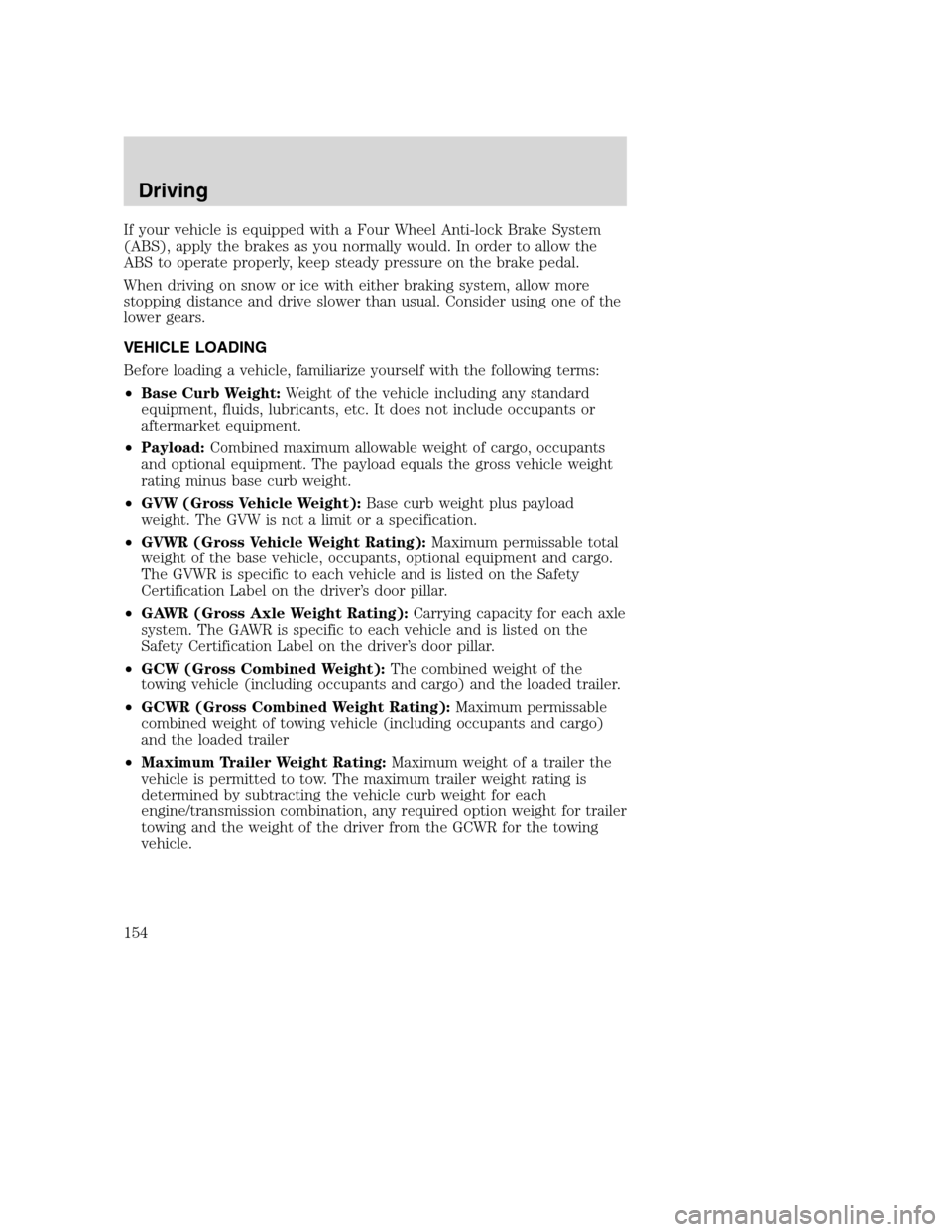
If your vehicle is equipped with a Four Wheel Anti-lock Brake System
(ABS), apply the brakes as you normally would. In order to allow the
ABS to operate properly, keep steady pressure on the brake pedal.
When driving on snow or ice with either braking system, allow more
stopping distance and drive slower than usual. Consider using one of the
lower gears.
VEHICLE LOADING
Before loading a vehicle, familiarize yourself with the following terms:
•Base Curb Weight:Weight of the vehicle including any standard
equipment, fluids, lubricants, etc. It does not include occupants or
aftermarket equipment.
•Payload:Combined maximum allowable weight of cargo, occupants
and optional equipment. The payload equals the gross vehicle weight
rating minus base curb weight.
•GVW (Gross Vehicle Weight):Base curb weight plus payload
weight. The GVW is not a limit or a specification.
•GVWR (Gross Vehicle Weight Rating):Maximum permissable total
weight of the base vehicle, occupants, optional equipment and cargo.
The GVWR is specific to each vehicle and is listed on the Safety
Certification Label on the driver’s door pillar.
•GAWR (Gross Axle Weight Rating):Carrying capacity for each axle
system. The GAWR is specific to each vehicle and is listed on the
Safety Certification Label on the driver’s door pillar.
•GCW (Gross Combined Weight):The combined weight of the
towing vehicle (including occupants and cargo) and the loaded trailer.
•GCWR (Gross Combined Weight Rating):Maximum permissable
combined weight of towing vehicle (including occupants and cargo)
and the loaded trailer
•Maximum Trailer Weight Rating:Maximum weight of a trailer the
vehicle is permitted to tow. The maximum trailer weight rating is
determined by subtracting the vehicle curb weight for each
engine/transmission combination, any required option weight for trailer
towing and the weight of the driver from the GCWR for the towing
vehicle.
Driving
154
Page 173 of 288
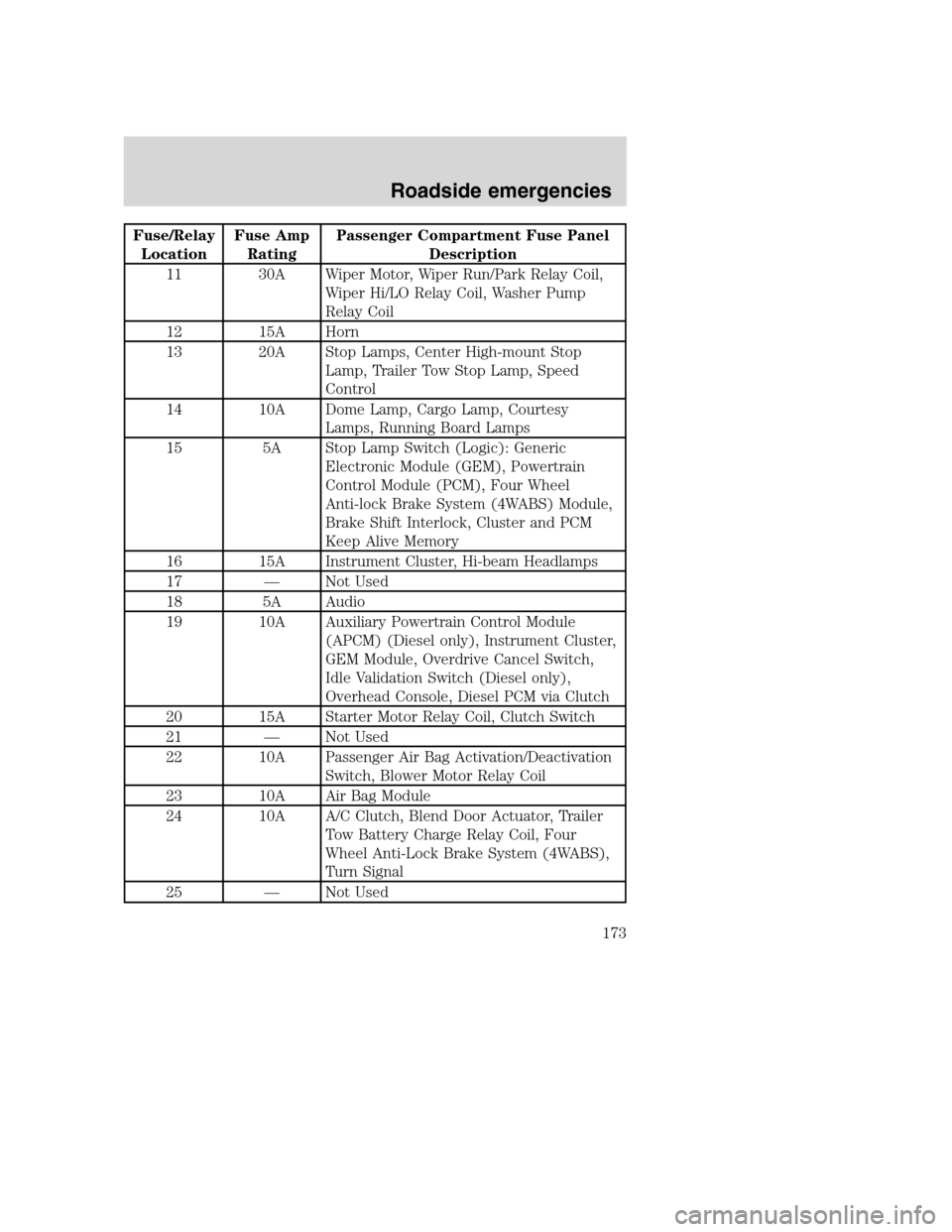
Fuse/Relay
LocationFuse Amp
RatingPassenger Compartment Fuse Panel
Description
11 30A Wiper Motor, Wiper Run/Park Relay Coil,
Wiper Hi/LO Relay Coil, Washer Pump
Relay Coil
12 15A Horn
13 20A Stop Lamps, Center High-mount Stop
Lamp, Trailer Tow Stop Lamp, Speed
Control
14 10A Dome Lamp, Cargo Lamp, Courtesy
Lamps, Running Board Lamps
15 5A Stop Lamp Switch (Logic): Generic
Electronic Module (GEM), Powertrain
Control Module (PCM), Four Wheel
Anti-lock Brake System (4WABS) Module,
Brake Shift Interlock, Cluster and PCM
Keep Alive Memory
16 15A Instrument Cluster, Hi-beam Headlamps
17 — Not Used
18 5A Audio
19 10A Auxiliary Powertrain Control Module
(APCM) (Diesel only), Instrument Cluster,
GEM Module, Overdrive Cancel Switch,
Idle Validation Switch (Diesel only),
Overhead Console, Diesel PCM via Clutch
20 15A Starter Motor Relay Coil, Clutch Switch
21 — Not Used
22 10A Passenger Air Bag Activation/Deactivation
Switch, Blower Motor Relay Coil
23 10A Air Bag Module
24 10A A/C Clutch, Blend Door Actuator, Trailer
Tow Battery Charge Relay Coil, Four
Wheel Anti-Lock Brake System (4WABS),
Turn Signal
25 — Not Used
Roadside emergencies
173
Page 228 of 288
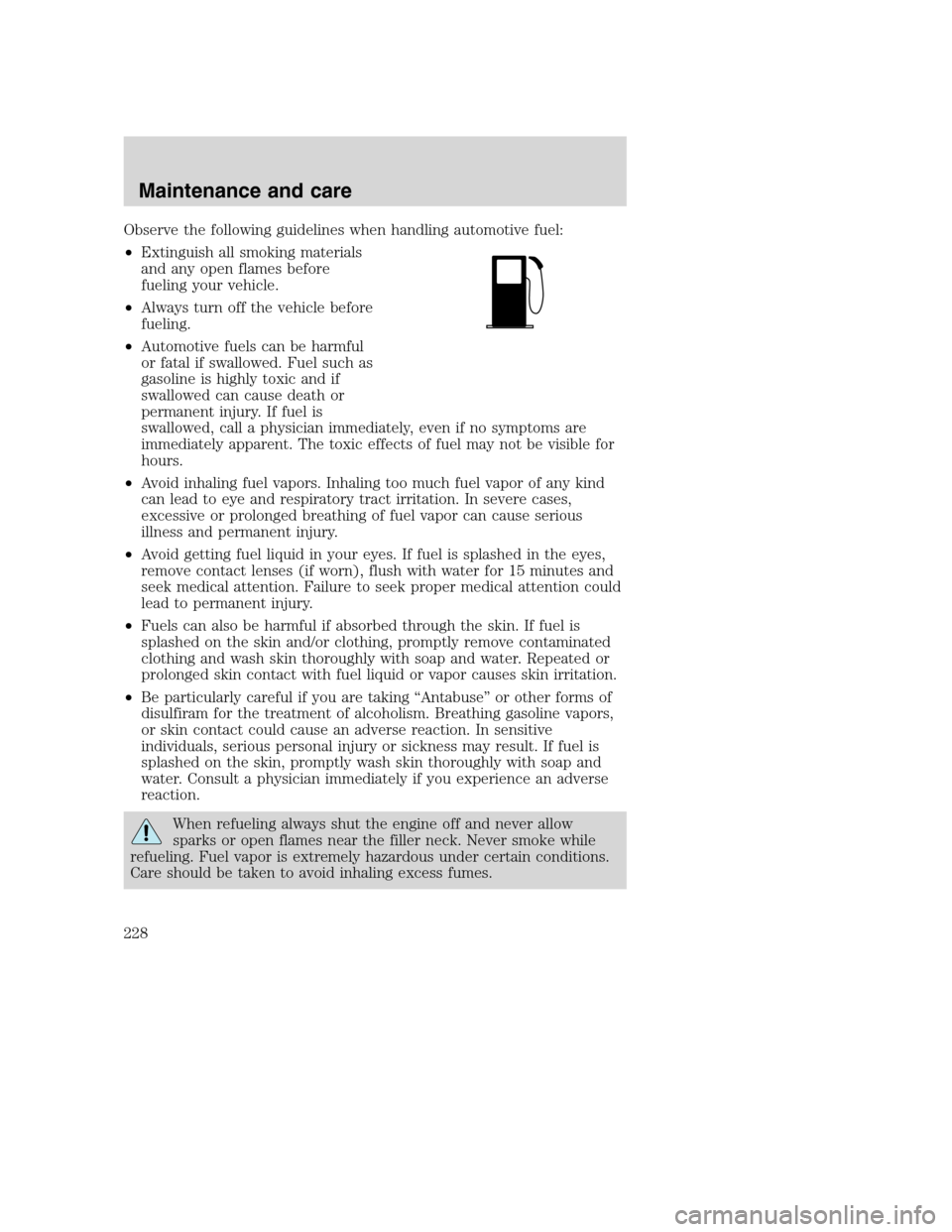
Observe the following guidelines when handling automotive fuel:
•Extinguish all smoking materials
and any open flames before
fueling your vehicle.
•Always turn off the vehicle before
fueling.
•Automotive fuels can be harmful
or fatal if swallowed. Fuel such as
gasoline is highly toxic and if
swallowed can cause death or
permanent injury. If fuel is
swallowed, call a physician immediately, even if no symptoms are
immediately apparent. The toxic effects of fuel may not be visible for
hours.
•Avoid inhaling fuel vapors. Inhaling too much fuel vapor of any kind
can lead to eye and respiratory tract irritation. In severe cases,
excessive or prolonged breathing of fuel vapor can cause serious
illness and permanent injury.
•Avoid getting fuel liquid in your eyes. If fuel is splashed in the eyes,
remove contact lenses (if worn), flush with water for 15 minutes and
seek medical attention. Failure to seek proper medical attention could
lead to permanent injury.
•Fuels can also be harmful if absorbed through the skin. If fuel is
splashed on the skin and/or clothing, promptly remove contaminated
clothing and wash skin thoroughly with soap and water. Repeated or
prolonged skin contact with fuel liquid or vapor causes skin irritation.
•Be particularly careful if you are taking “Antabuse” or other forms of
disulfiram for the treatment of alcoholism. Breathing gasoline vapors,
or skin contact could cause an adverse reaction. In sensitive
individuals, serious personal injury or sickness may result. If fuel is
splashed on the skin, promptly wash skin thoroughly with soap and
water. Consult a physician immediately if you experience an adverse
reaction.
When refueling always shut the engine off and never allow
sparks or open flames near the filler neck. Never smoke while
refueling. Fuel vapor is extremely hazardous under certain conditions.
Care should be taken to avoid inhaling excess fumes.
Maintenance and care
228
Page 231 of 288
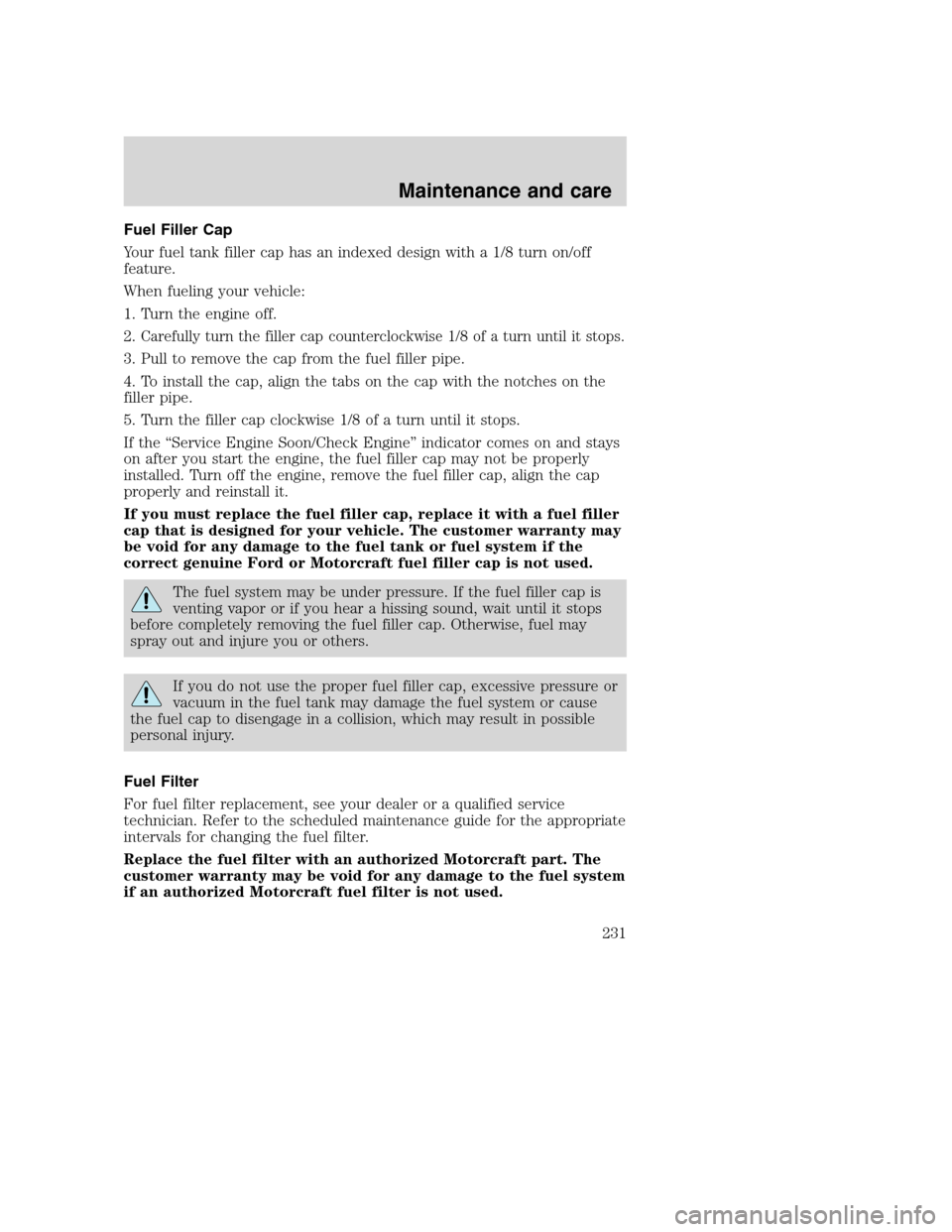
Fuel Filler Cap
Your fuel tank filler cap has an indexed design with a 1/8 turn on/off
feature.
When fueling your vehicle:
1. Turn the engine off.
2.
Carefully turn the filler cap counterclockwise 1/8 of a turn until it stops.
3. Pull to remove the cap from the fuel filler pipe.
4. To install the cap, align the tabs on the cap with the notches on the
filler pipe.
5. Turn the filler cap clockwise 1/8 of a turn until it stops.
If the “Service Engine Soon/Check Engine” indicator comes on and stays
on after you start the engine, the fuel filler cap may not be properly
installed. Turn off the engine, remove the fuel filler cap, align the cap
properly and reinstall it.
If you must replace the fuel filler cap, replace it with a fuel filler
cap that is designed for your vehicle. The customer warranty may
be void for any damage to the fuel tank or fuel system if the
correct genuine Ford or Motorcraft fuel filler cap is not used.
The fuel system may be under pressure. If the fuel filler cap is
venting vapor or if you hear a hissing sound, wait until it stops
before completely removing the fuel filler cap. Otherwise, fuel may
spray out and injure you or others.
If you do not use the proper fuel filler cap, excessive pressure or
vacuum in the fuel tank may damage the fuel system or cause
the fuel cap to disengage in a collision, which may result in possible
personal injury.
Fuel Filter
For fuel filter replacement, see your dealer or a qualified service
technician. Refer to the scheduled maintenance guide for the appropriate
intervals for changing the fuel filter.
Replace the fuel filter with an authorized Motorcraft part. The
customer warranty may be void for any damage to the fuel system
if an authorized Motorcraft fuel filter is not used.
Maintenance and care
231
Page 240 of 288

5. Carefully pull bulb straight out of
the socket and push in the new
bulb.
6. Install the bulb socket in lamp
assembly by turning clockwise.
7. Align the lamp assembly on the
vehicle.
8. Install two screws on parking
lamp/turn signal assembly.
Replacing tail lamp/turn/backup lamp bulbs — F250/F350 only
The tail lamp/backup lamp bulbs are
located in the same portion of the
tail lamp assembly, one just below
the other. Follow the same steps to
replace either bulb:
1. Open the tailgate to expose the
lamp assemblies.
2. Remove the two bolts from the
tail lamp assembly.
3. Carefully pull the lamp assembly
from the tailgate pillar by releasing
the two retaining tabs.
4. Twist the bulb socket
1�4turn counterclockwise and remove from lamp
assembly.
5. Pull the bulb straight out of the socket and push in the new bulb.
6. Install bulb socket in lamp assembly by turning clockwise.
7. Carefully install the tail lamp assembly on tailgate pillar snapping the
two retaining tabs into place.
8. Secure the tail lamp with two bolts.
Maintenance and care
240
Page 257 of 288
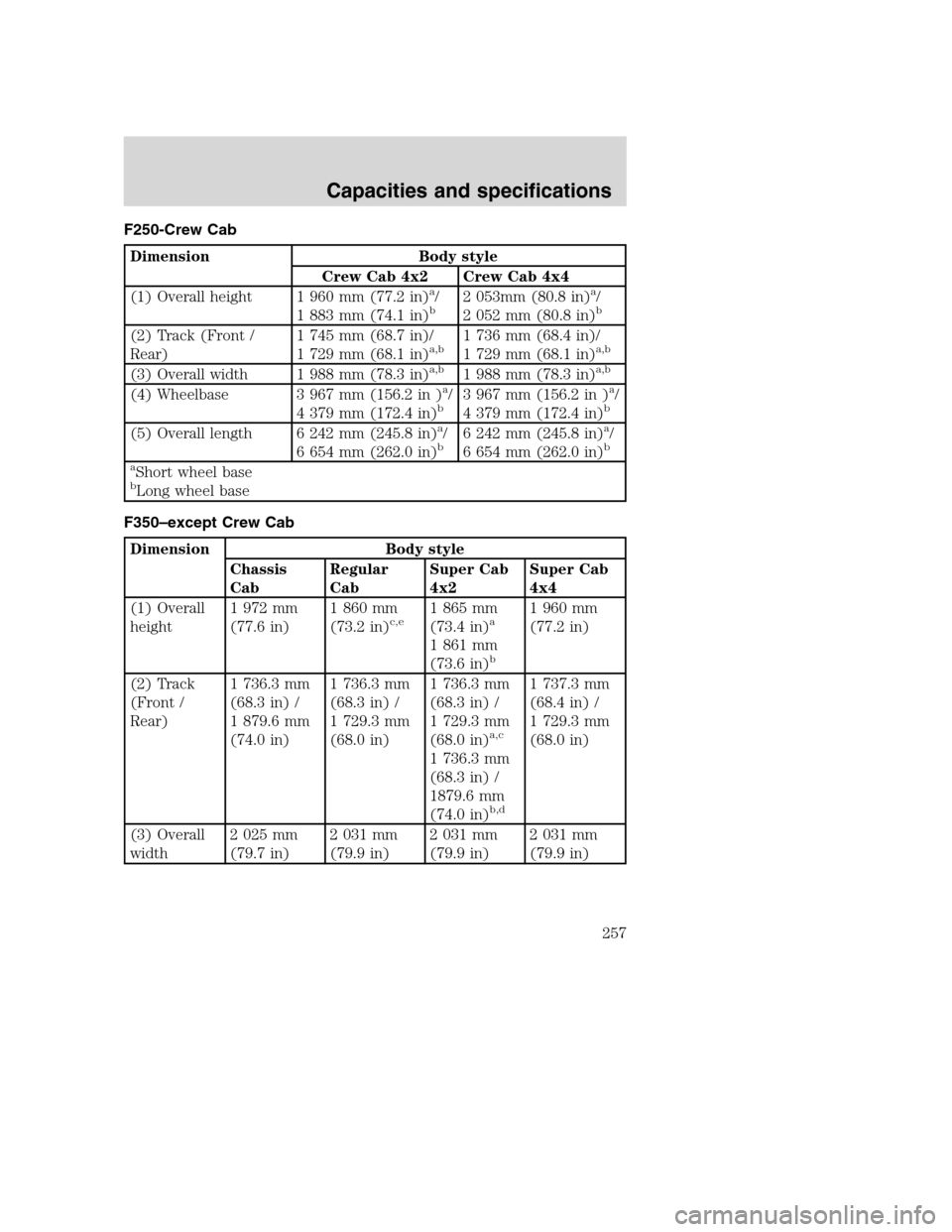
F250-Crew Cab
Dimension Body style
Crew Cab 4x2 Crew Cab 4x4
(1) Overall height 1 960 mm (77.2 in)
a/
1 883 mm (74.1 in)b2 053mm (80.8 in)a/
2 052 mm (80.8 in)b
(2) Track (Front /
Rear)1 745 mm (68.7 in)/
1 729 mm (68.1 in)a,b1 736 mm (68.4 in)/
1 729 mm (68.1 in)a,b
(3) Overall width 1 988 mm (78.3 in)a,b1 988 mm (78.3 in)a,b
(4) Wheelbase 3 967 mm (156.2 in )a/
4 379 mm (172.4 in)b3 967 mm (156.2 in )a/
4 379 mm (172.4 in)b
(5) Overall length 6 242 mm (245.8 in)a/
6 654 mm (262.0 in)b6 242 mm (245.8 in)a/
6 654 mm (262.0 in)b
a
Short wheel basebLong wheel base
F350–except Crew Cab
Dimension Body style
Chassis
CabRegular
CabSuper Cab
4x2Super Cab
4x4
(1) Overall
height1 972 mm
(77.6 in)1 860 mm
(73.2 in)
c,e1 865 mm
(73.4 in)a
1 861 mm
(73.6 in)b
1 960 mm
(77.2 in)
(2) Track
(Front /
Rear)1 736.3 mm
(68.3 in) /
1 879.6 mm
(74.0 in)1 736.3 mm
(68.3 in) /
1 729.3 mm
(68.0 in)1 736.3 mm
(68.3 in) /
1 729.3 mm
(68.0 in)
a,c
1 736.3 mm
(68.3 in) /
1879.6 mm
(74.0 in)
b,d
1 737.3 mm
(68.4 in) /
1 729.3 mm
(68.0 in)
(3) Overall
width2 025 mm
(79.7 in)2 031 mm
(79.9 in)2 031 mm
(79.9 in)2 031 mm
(79.9 in)
Capacities and specifications
257
Page 258 of 288
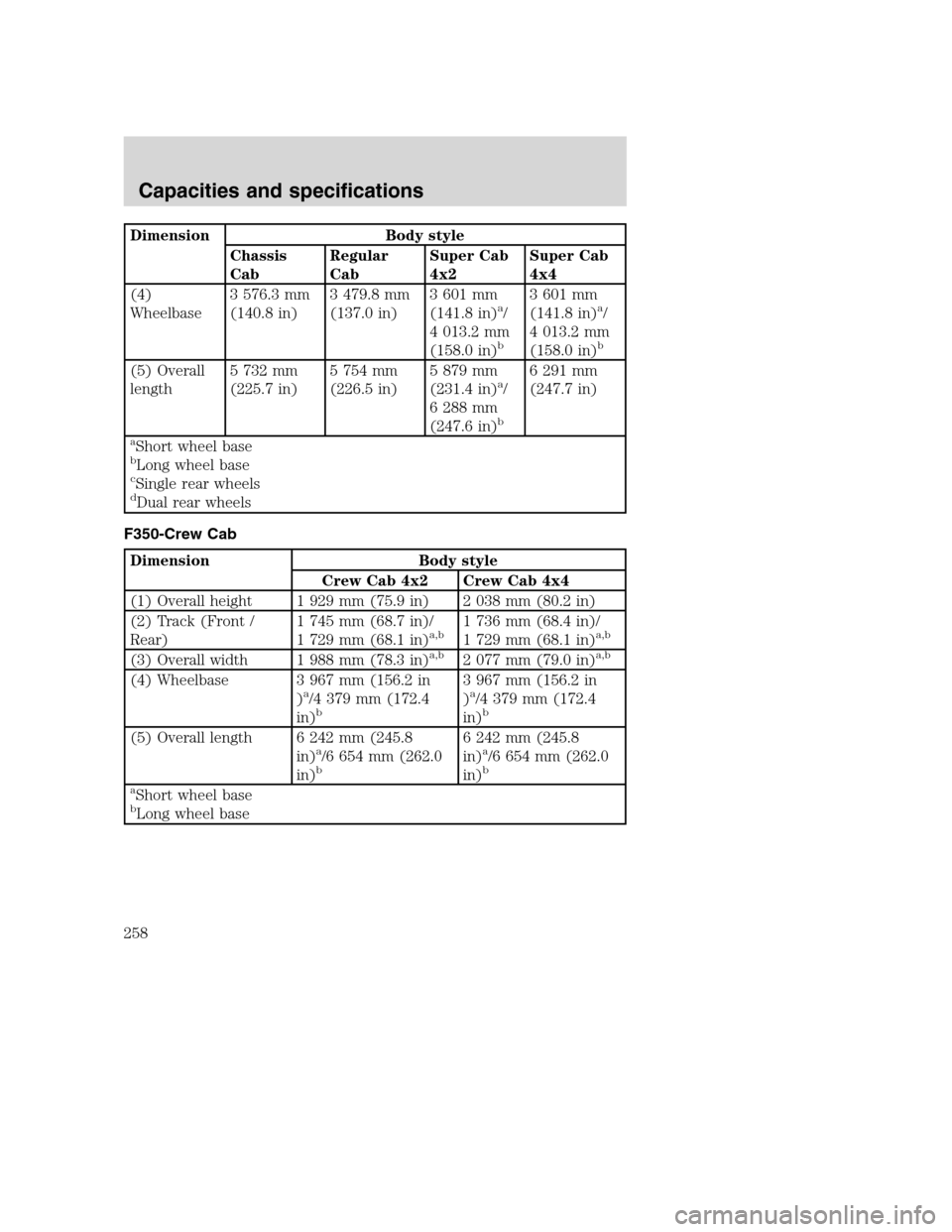
Dimension Body style
Chassis
CabRegular
CabSuper Cab
4x2Super Cab
4x4
(4)
Wheelbase3 576.3 mm
(140.8 in)3 479.8 mm
(137.0 in)3 601 mm
(141.8 in)
a/
4 013.2 mm
(158.0 in)
b
3 601 mm
(141.8 in)a/
4 013.2 mm
(158.0 in)
b
(5) Overall
length5 732 mm
(225.7 in)5 754 mm
(226.5 in)5 879 mm
(231.4 in)a/
6 288 mm
(247.6 in)
b
6 291 mm
(247.7 in)
aShort wheel basebLong wheel basecSingle rear wheelsdDual rear wheels
F350-Crew Cab
Dimension Body style
Crew Cab 4x2 Crew Cab 4x4
(1) Overall height 1 929 mm (75.9 in) 2 038 mm (80.2 in)
(2) Track (Front /
Rear)1 745 mm (68.7 in)/
1 729 mm (68.1 in)
a,b1 736 mm (68.4 in)/
1 729 mm (68.1 in)a,b
(3) Overall width 1 988 mm (78.3 in)a,b2 077 mm (79.0 in)a,b
(4) Wheelbase 3 967 mm (156.2 in
)a/4 379 mm (172.4
in)b
3 967 mm (156.2 in
)a/4 379 mm (172.4
in)b
(5) Overall length 6 242 mm (245.8
in)a/6 654 mm (262.0
in)b
6 242 mm (245.8
in)a/6 654 mm (262.0
in)b
a
Short wheel basebLong wheel base
Capacities and specifications
258
Page 278 of 288
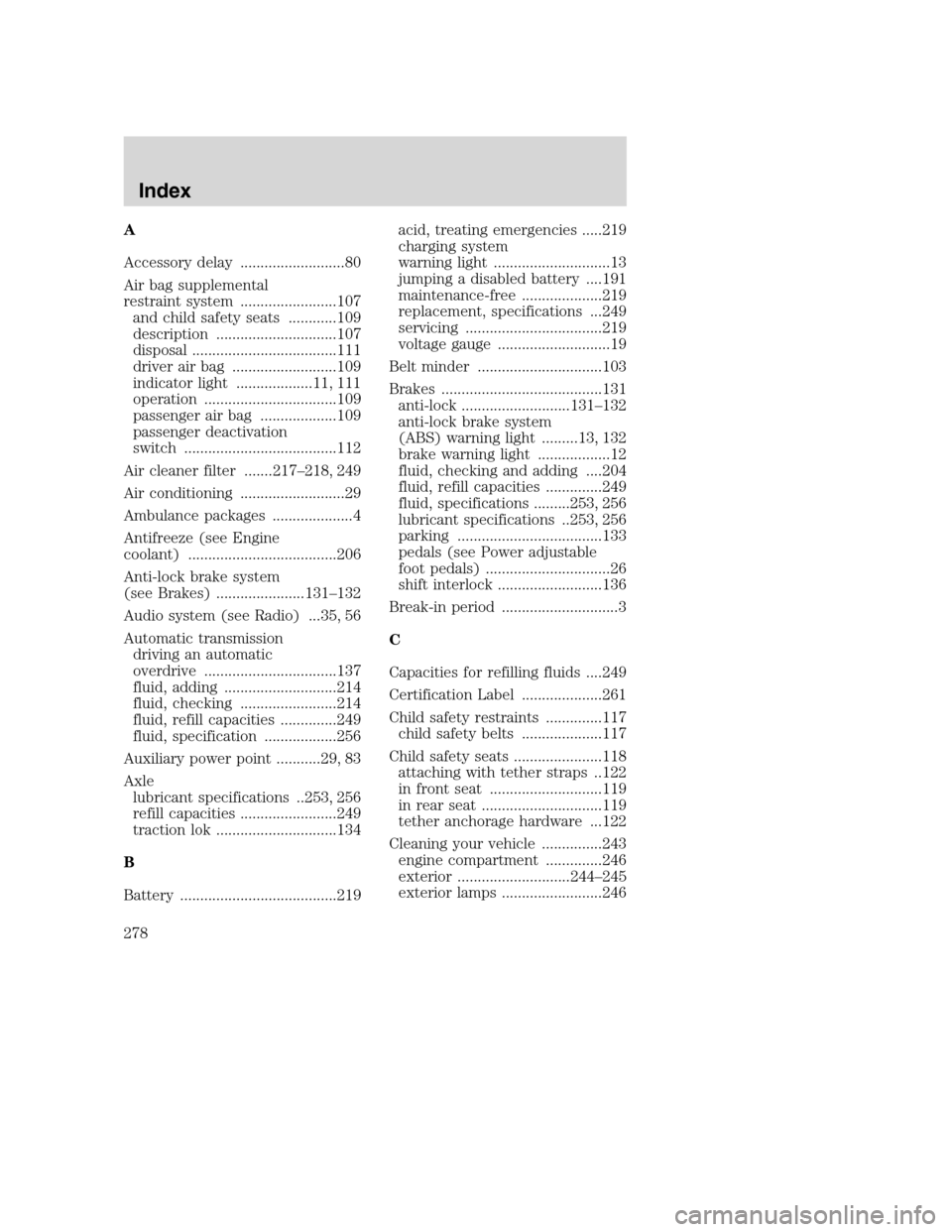
A
Accessory delay ..........................80
Air bag supplemental
restraint system ........................107
and child safety seats ............109
description ..............................107
disposal ....................................111
driver air bag ..........................109
indicator light ...................11, 111
operation .................................109
passenger air bag ...................109
passenger deactivation
switch ......................................112
Air cleaner filter .......217–218, 249
Air conditioning ..........................29
Ambulance packages ....................4
Antifreeze (see Engine
coolant) .....................................206
Anti-lock brake system
(see Brakes) ......................131–132
Audio system (see Radio) ...35, 56
Automatic transmission
driving an automatic
overdrive .................................137
fluid, adding ............................214
fluid, checking ........................214
fluid, refill capacities ..............249
fluid, specification ..................256
Auxiliary power point ...........29, 83
Axle
lubricant specifications ..253, 256
refill capacities ........................249
traction lok ..............................134
B
Battery .......................................219acid, treating emergencies .....219
charging system
warning light .............................13
jumping a disabled battery ....191
maintenance-free ....................219
replacement, specifications ...249
servicing ..................................219
voltage gauge ............................19
Belt minder ...............................103
Brakes ........................................131
anti-lock ...........................131–132
anti-lock brake system
(ABS) warning light .........13, 132
brake warning light ..................12
fluid, checking and adding ....204
fluid, refill capacities ..............249
fluid, specifications .........253, 256
lubricant specifications ..253, 256
parking ....................................133
pedals (see Power adjustable
foot pedals) ...............................26
shift interlock ..........................136
Break-in period .............................3
C
Capacities for refilling fluids ....249
Certification Label ....................261
Child safety restraints ..............117
child safety belts ....................117
Child safety seats ......................118
attaching with tether straps ..122
in front seat ............................119
in rear seat ..............................119
tether anchorage hardware ...122
Cleaning your vehicle ...............243
engine compartment ..............246
exterior ............................244–245
exterior lamps .........................246
Index
278